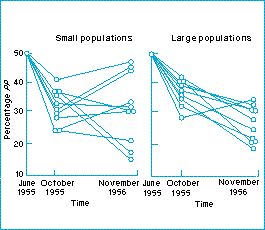Genetic drift

The frequency of alleles with the same fitness may change at random through time in a process called genetic drift.
If there are two alleles at a locus, and they have the same fitness, random sampling can cause their relative frequencies in a population to change. Genetic drift has important consequences for the random substitution of genes and the Hardy-Weinberg equilibrium.
The rate of change of gene frequency by random drift depends on the size of the population. Random sampling effects are more important in smaller populations. Imagine flipping 10 sets of 20, or 4000, coins. On average, there would be 50% heads in both cases, but the chance of flipping 12 heads and eight tails in the small population is higher than the chance of flipping 2400 heads and 1600 tails in the large. If a population is small, it is more likely that a sample will be biased away from the average by any given percentage amount; genetic drift is therefore greater in smaller populations. The smaller the population, the more important are the effects of random sampling; this was shown in Dobzhansky's experiments with fruitflies (results opposite).
What effect does genetic drift have on the Hardy-Weinberg equilibrium?
Figure: random sampling is more effective in small populations. Ten large (4000 founders) and ten small (20 founders) populations of the fruitfly Drosophila pseudoobscura were created with the same frequencies (50% each) of two chromosomal inversions, AP and PP. After 18 months, the populations with small numbers of founders show a greater variety of genotype frequencies. From Dobzhansky (1970).
| Next |



